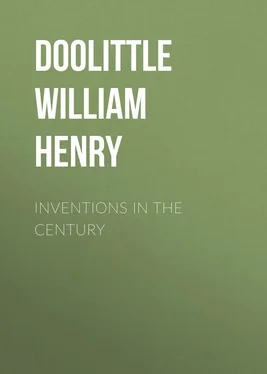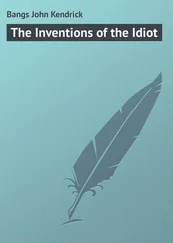William Doolittle - Inventions in the Century
Здесь есть возможность читать онлайн «William Doolittle - Inventions in the Century» — ознакомительный отрывок электронной книги совершенно бесплатно, а после прочтения отрывка купить полную версию. В некоторых случаях можно слушать аудио, скачать через торрент в формате fb2 и присутствует краткое содержание. Жанр: foreign_antique, foreign_prose, на английском языке. Описание произведения, (предисловие) а так же отзывы посетителей доступны на портале библиотеки ЛибКат.
- Название:Inventions in the Century
- Автор:
- Жанр:
- Год:неизвестен
- ISBN:нет данных
- Рейтинг книги:5 / 5. Голосов: 1
-
Избранное:Добавить в избранное
- Отзывы:
-
Ваша оценка:
- 100
- 1
- 2
- 3
- 4
- 5
Inventions in the Century: краткое содержание, описание и аннотация
Предлагаем к чтению аннотацию, описание, краткое содержание или предисловие (зависит от того, что написал сам автор книги «Inventions in the Century»). Если вы не нашли необходимую информацию о книге — напишите в комментариях, мы постараемся отыскать её.
Inventions in the Century — читать онлайн ознакомительный отрывок
Ниже представлен текст книги, разбитый по страницам. Система сохранения места последней прочитанной страницы, позволяет с удобством читать онлайн бесплатно книгу «Inventions in the Century», без необходимости каждый раз заново искать на чём Вы остановились. Поставьте закладку, и сможете в любой момент перейти на страницу, на которой закончили чтение.
Интервал:
Закладка:
Modern countries especially are waking up to the necessity of good roads, not only as a necessary means of transportation, but as a pre-requisite to decent civilisation in all respects. And, therefore, great activity has been had in the last third of a century in invention of machines for finishing and repairing roads.
In the matter of sewer construction, regarded now so necessary in all civilised cities and thickly-settled communities as one of the means of proper sanitation, great improvements have been made in deep sewerage, in which the work is largely performed below the surface and with little obstruction to street traffic.
In connection with excavating and dredging machines, mention should be made of those great works in the construction of which they bore such important parts, as drainage and land reclamation, such as is seen in the modern extensions of land reclamation in Holland, in the Haarlem lake district in the North part of England, the swamps of Florida and the drainage of the London district; in modern tunnels such as the Hoosac in America and the three great ones through the Alps: the Mont Cenis, St. Gothard, and Arlberg, the work in which developed an entirely new system of engineering, by the application of newly-discovered explosives for blasting, new rock-drilling machinery, new air-compressing machines for driving the drill machines and ventilating the works, and new hydraulic and pumping machinery for sinking shafts and pumping out the water.
The great canals, especially the Suez, developed a new system of canal engineering. Thus by modern inventions of devices for digging and blasting, dredging and draining and attendant operations, some of the greatest works of man on earth have been produced, and evinced the exercise of his highest inventive genius.
If one wishes an ocular demonstration of the wonders wrought in the 19th century in the several domains of engineering, let him take a Pullman train across the continent from New York to San Francisco. The distance is 3,000 miles and the time is four days and four nights. The car in which the passenger finds himself is a marvel of woodwork and upholstery – a description of the machinery and processes for producing which belongs to other arts. The railroad tracks upon which the vehicle moves are in themselves the results of many inventions. There is the width of the track, and it was only after a long and expensive contest that countries and corporations settled upon a uniform gauge. The common gauge of the leading countries and roads is now 4 feet 8½ inches. A greater width is known as a broad gauge, a less width as a narrow gauge. Then as to the rail: first the wooden, then the iron and now the steel, and all of many shapes and weights. The T-rail invented by Birkensaw in 1820, having two flanges at the top to form a wide berth for the wheels of the rolling stock, the vertical portion gripped by chairs which are spiked to the ties, is the best known. Then the frogs, a V-shaped device by which the wheels are guided from one line of rails to another, when they form angles with each other; the car wheel made with a flange or flanges to fit the rail, and the railway gates, ingenious contrivances that guard railway crossings and are operated automatically by the passing trains, but more commonly by watchmen. The car may be lighted with electricity, and as the train dashes along at the rate of 30 to 80 miles an hour, it may be stopped in less than a minute by the touch of the engineer on an air brake. Is it midwinter and are mountains of snow encountered? They disappear before the railway snow-plough more quickly than they came. It passes over bridges, through tunnels, across viaducts, around the edges of mountain peaks, every mile revealing the wondrous work of man's inventive genius for encompassing the earth with speed, safety and comfort. Over one-half million miles of these railway tracks are on the earth's surface to-day!
Not only has the railway superseded horse power in the matter of transportation to a vast extent, but other modes of transportation are taking the place of that useful animal. The old-fashioned stage coach, and then the omnibus, were successively succeeded by the street car drawn by horses, and then about twenty years ago the horse began to be withdrawn from that work and the cable substituted.
Cable transportation developed from the art of making iron wire and steel wire ropes or cables. And endless cables placed underground, conveyed over rollers and supported on suitable yokes, and driven from a great central power house, came into use, and to which the cars were connected by ingeniously contrived lever grips – operated by the driver on the car. These great cable constructions, expensive as they were, were found more economical than horse power. In fact, there is no modernly discovered practical motive power but what has been found less expensive both as to time and money than horse power. But the cable for this purpose is now in turn everywhere yielding to electricity, the great motor next to steam. The overhead cable system for the transportation of materials of various descriptions in carriers, also run by a central motor, is still very extensively used. The cable plan has also been tried with some success in the propelling of canal boats.
Canals , themselves, although finding a most serious and in some localities an entirely destructive rival in the railroad, have grown in size and importance, and in appliances that have been substituted for the old-style locks. The latest form of this device is what is known as the pneumatic balance lock system.
It has been said by Octave Chanute that "Progress in civilisation may fairly be said to be dependent upon the facilities for men to get about, upon their intercourse with other men and nations, not only in order to supply their mutual needs cheaply, but to learn from each other their wants, their discoveries and their inventions." Next to the power and means for moving people, come the immense and wonderful inventions for lifting and loading, such as cranes and derricks, means for coaling ships and steamers, for handling and storing the great agricultural products, grain and hay, and that modern wonder, the grain elevator , that dots the coasts of rivers, lakes and seas, receives the vast stores of golden grain from thousands of steam cars that come to it laden from distant plains and discharges it swiftly in mountain loads into vessels and steamers to be carried to the multitudes across the seas, and to satisfy that ever-continuing cry, "Give us this day our daily bread."
CHAPTER IX.
ELECTRICITY
In 1900 the real nature of electricity appears to be as unknown as it was in 1800.
Franklin in the eighteenth century defined electricity as consisting of particles of matter incomparably more subtle than air, and which pervaded all bodies. At the close of the nineteenth century electricity defined as "simply a form of energy which imparts to material substances a peculiar state or condition, and that all such substances partake more or less of this condition."
These theories and the late discovery of Hertz that electrical energy manifests itself in the form of waves, oscillations or vibrations, similar to light, but not so rapid as the vibrations of light, constitute about all that is known about the nature of this force.
Franklin believed it was a single fluid, but others taught that there were two kinds of electricity, positive and negative, that the like kinds were repulsive and the unlike kinds attractive, and that when generated it flowed in currents.
Such terms are not now regarded as representing actual varieties of this force, but are retained as convenient modes of expression, for want of better ones, as expressing the conditions or states of electricity when produced.
Читать дальшеИнтервал:
Закладка:
Похожие книги на «Inventions in the Century»
Представляем Вашему вниманию похожие книги на «Inventions in the Century» списком для выбора. Мы отобрали схожую по названию и смыслу литературу в надежде предоставить читателям больше вариантов отыскать новые, интересные, ещё непрочитанные произведения.
Обсуждение, отзывы о книге «Inventions in the Century» и просто собственные мнения читателей. Оставьте ваши комментарии, напишите, что Вы думаете о произведении, его смысле или главных героях. Укажите что конкретно понравилось, а что нет, и почему Вы так считаете.












